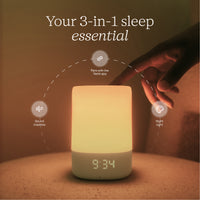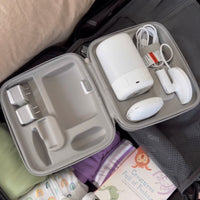So, your little angel who slept like a teenager for the first three months of their life is now sleeping like a baby – aka, waking up every few hours and popping their eyes open at the drop of a pen, or the click of the door as you leave the room? While many would call this shift a sleep regression, experts say it’s more like a sleep progression, showing that your baby is properly developing, physically, cognitively, and emotionally.
But, even though your long nights spent with your eyes wide-open babe indicate positive progress, it can also wreak havoc on your sanity and health. Instead of just grin and bearing through many months of sleepless nights, understanding the factors that impact baby’s sleep as they develop will allow you to make adjustments that enhance their (and your) ability to catch some zzzs.
Here are the most common shifts occurring in your child’s world around their four-month birthday, and how to work with them so they don’t siphon away all your slumber:
4 Month Sleep Regression: Heightened Curiosity
While your baby spends the first few months of life getting used to not being in a cozy in-utero suite, they’re now ready to start taking in and enjoying their surroundings. This heightened curiosity, which is brought about by baby’s ability to begin using their primary senses (hearing, vision, taste, and touch), causes them to be much more sensitive to where they can and cannot fall asleep.
While your baby might have had no trouble falling asleep in the grocery store, car, movie theater, or other stimulating environments in those first few months, they now have FOMO (fear or missing out) and have little interest in snoozing when they can be checking out all the interesting colors, lights, sounds, tastes, and movements around them.
To prevent this heightened curiosity from putting up a block between your baby and sweet sleep, put more planning into your baby’s sleep schedule. Start paying attention to the common times throughout the day your baby seems to be sleepy and adjust your schedule to ensure you can have them in a quiet (or white noise filled), cool, comfortable, and dark space during those times. Minimizing the amount of stimulation baby has during their down time will up their chances of drifting into dream world, instead of powering through sleepy times and ending up fussy and fatigued.
4 Month Sleep Regression: Sensitivity to Change
Newborns are pretty adaptable to change, as long as they’re with you, but as they become more aware they become more sensitive to situations like travel, a new home, different people, or even a shift in the composition of breast milk if your diet changes.
If you notice your baby’s sleep habits beginning to shift, think about changes that have happened in their world and how to make the necessary adjustments to help them ease back into being a successful sleeper. For example, if you’ve just been on a trip where a time change occurred, you can try to get them back to an optimal bedtime by adjusting the time you begin their nighttime routine by thirty minute increments (either earlier or later, depending on what direction you traveled).
4 Month Sleep Regression: Enhanced Motor Skills
Babies become more dexterous around 4 months and are able to do more with their hands, like shake a rattle, grab a stuffed animal (or your hair!), or even roll over. Because these new abilities can tire baby out, use them to your advantage by providing plenty of safe opportunities for baby to explore their new abilities. Pay attention to your baby’s sleep signals (like rubbing their eyes, yawning, becoming fussy, or anything else you notice they do when they’re getting tired) as they play and transition them to their sleepy space when they show these signs.
4 Month Sleep Regression: Ability to Self-Soothe
Around four months of age babies become more apt at being able to learn to soothe themselves back to sleep. 80% of children wake at night, but many parents wouldn’t even know it because their child has the ability to drift back into sleep without assistance. Because self-soothing is a learned skill, allow your baby to hone this ability by giving them some time and space to fall back asleep, which they might do with the assistance of a self-soothing technique like sucking on their hand, for example. Use your judgment when it comes to how much time you want to give baby before you go in and support them in the soothing process – trust your instincts.
It’s also important to know that it’s common for babies to whimper and moan, or fall into strange breathing patterns, when in REM (rapid eye movement) sleep. And occasionally, the sounds and movements that can accompany REM sleep, or the transitions into or out of it, might trick you into thinking your babe is awake. So, when it sounds like baby is up and at ‘em take a few beats before you rush to soothe them, because it’s very possible that they may slip back sleep.
4 Month Sleep Regression: Be Gentle With Yourself
First and foremost, you’re likely a mombie (mommy zombie) if you’re moving through the four-month sleep regression with your baby and deserve to rest as often as you’re able. Stick to the “sleep when baby sleeps” motto, so popular in the first few weeks of baby’s life, regardless of how much laundry, emails, or dishes you have.
In addition, know that sleep tips and tricks can only do so much and work in varying degrees of success with each child. So, if you’ve tried everything and your baby still refuses to sleep more than 30-minutes at a time, don’t label yourself as a “bad parent” and know that if you keep working at it there will come a time when you and baby get a blessed five straight hours of sleep.
Parenting is a wild ride of rapids, rowing up stream, and getting tossed from your boat, but find solace in knowing that there will be times when it turns into a lazy river that will let you drift into gentle dreams with your baby by your side.












































